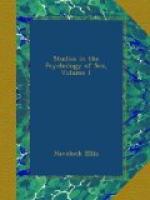[254] As Gilles de la Tourette points out, it is not difficult to show that epilepsy, the morbus sacer of the ancients, owed much of its sacred character to this confusion with hysteria. Those priestesses who, struck by the morbus sacer, gave forth their oracles amid convulsions, were certainly not the victims of epilepsy, but of hysteria (Traite de l’Hysterie, vol. i, p. 3).
[255] Aretaeus, On the Causes and Symptoms of Acute Diseases, Book ii, Chapter II.
[256] It may be noted that this treatment furnishes another instance of the continuity of therapeutic methods, through all changes of theory, from the earliest to the latest times. Drugs of unpleasant odor, like asafoetida, have always been used in hysteria, and scientific medicine to-day still finds that asafoetida is a powerful sedative to the uterus, controlling nervous conditions during pregnancy and arresting uterine irritation when abortion is threatened (see, e.g., Warman, Der Frauenarzt, August, 1895). Again, the rubbing of fragrant ointments into the sexual regions is but a form of that massage which is one of the modern methods of treating the sexual disorders of women.
[257] Les Demoniaques dans l’Art, 1887; Les Malades et les Difformes dans l’Art, 1889.
[258] Glafira Abricosoff, of Moscow, in her Paris thesis, L’Hysterie aux xvii et xviii siecles, 1897, presents a summary of the various views held at this time; as also Gilles de la Tourette, Traite de l’Hysterie, vol. i, Chapter I.
[259] Edinburgh Medical Journal, June, 1883, p. 1123, and Mental Diseases, 1887, p. 488.
[260] Hegar, Zusammenhang der Geschlechtskrankheiten mit nervoesen Leiden, Stuttgart, 1885. (Hegar, however, went much further than this, and was largely responsible for the surgical treatment of hysteria now generally recognized as worse than futile.) Balls-Headley, “Etiology of Nervous Diseases of the Female Genital Organs,” Allbutt and Playfair, System of Gynecology, 1896, p. 141.
[261] Lombroso and Ferrero, La Donna Delinquente, 1893, pp. 613-14.
[262] Charcot and Marie, article on “Hysteria,” Tuke’s Dictionary of Psychological Medicine.
[263] Axenfeld and Huchard, Traite des Nevroses, 1883, pp. 1092-94. Icard (La Femme pendant la Periode Menstruelle, pp. 120-21) has also referred to recorded cases of hysteria in animals (Coste’s and Peter’s cases), as has Gilles de la Tourette (op. cit., vol. i, p. 123). See also, for references, Fere, L’Instinct Sexuel, p. 59.
[264] Man and Woman, 4th ed., p. 326. A distinguished gynaecologist, Matthews Duncan, had remarked some years earlier (Lancet, May 18, 1889) that hysteria, though not a womb disease, “especially attaches itself to the generative system, because the genital system, more than any other, exerts emotional power over the individual, power also in morals, power in social questions.”




